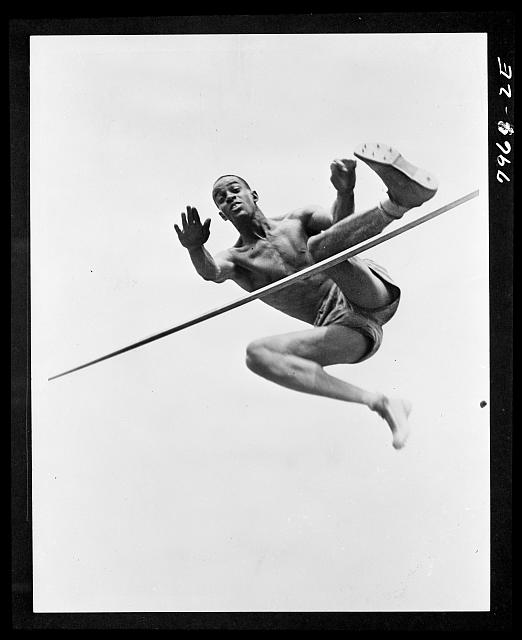
Justin Jeske-Word Press
In the summer of 1936, the entire world had their eyes on Berlin, where Nazi Germany was determined to show their country as not just a global power, but their racial superiority through the 1936 Olympic games. Despite all the racism, fascism, and propaganda, African American athletes from the US showed up and dominated. One of the most powerful moments from the Olympic games is captured in the Untitled Photo of Cornelius Johnson at the Olympics, preserved in the Farm Security Administration office of War Information Photograph Collection at the library of Congress. In this photograph, we see Johnson soaring over the high jump bar with ease, before securing the gold medal for the United States. This is photo is so much more than a man doing the high jump, this photo is a visual remembrance of the racial pride that African American athletes had while competing under such circumstances, being amid a regime that was being built on pure hatred1.
It wasn’t just Cornelius Johnson: Jesse Owens, Dave Albritton were other black athletes that competed during the 1936 Olympic games. Just their representation carried such a symbolic meaning. Both Germany and the United States had their struggles with racism. The Germans were building their Nazi regime, while the United States had its Jim Crow laws that allowed racial segregation. Historian Sayuri Guthrie-Shimizu says that that “Between 1933 and 1936, however, U.S citizens of all political stripes and religious persuasions debated intensely the wisdom of sending U.S athletes to the games that would be hosted by a regime sworn to racist ideology”2. Johnsons triumph on German soil this resonated far beyond sports, it was the embodiment of perseverance, and a symbol of American strength while still having to endure racism when he got back home to the states.
The photos created by the Farm Security Administration (FSA) are equally powerful. The FSA during the 1930s documented American life during the Great Depression and was there to humanize less fortunate communities. 3 The 1930s was a very dark time for everyone, you had the Great Depression era, along with the Nazi regime growing. In addition to that, you still had segregation in the United States. For Germany, Hitler used the Olympics to promote his Aryan superiority ideology and so that it can recognized on a world stage. On the other hand, in the United States black Americans like Johnson faced segregation, and racial violence under Jim Crow. This is ironic because you have Black Athletes representing their country, and their country does not even like them. His success really emphasized the irony America had when putting Black athletes to represent them in the Olympics. By capturing a Black athlete in a moment of power, the photograph both documents and challenges the racial ideologies that were in place during the 1930s, symbolizing a chance at hope, and a better future for African Americans.
Diving deeper into the meaning of this photo, we see Johnson soaring over the high beam with power, confidence, and determination. This photo captures the idea of rising above the barrier of limitations that were put in place by racism for both Germany and America. His concentration in the picture represents his inner strength, which was essential if you were a Black man representing America during the 1936 Olympics in Germany.
The broader historical context shows how defiant this moment really was. Hitlers famously didn’t shake hands with Johnson after winning gold. As historian John Gleaves explains that after being snubbed by Hitler, “Johnson, Albritton and Thurber appear to have performed the Bellamy Salute which was an act of American patriotism that predated the Nazi, Fascist, and Olympic Salutes by about 30 years.”4 By the African Americans refusing to do the Nazi salute, it was an act of patriotism which transformed a sporting event into a powerful message heard around the world.
For African Americans in 1936, Johnson’s victory was a huge source of pride. His success completely combatted white supremacists from both Germany and America. Through the photo’s composition and historical setting, it embodies how African Americans established themselves as being a part of America. The FSA photographers captured more than just a man in motion, but an advancing stride in the right direction for Black citizens in America.
Works cited:
Historical source: Untitled photo shows: Cornelius Johnson, winner of the gold medal at theOlympics, in a high jump., 1936. Photograph. https://www.loc.gov/item/2017767777/.
Footnotes:
1. “Untitled photo shows: Cornelius Johnson, winner of the gold medal at the Olympics, in a high jump,” Farm Security Administration – Office of War Information Photograph Collection, Library of Congress, https://www.loc.gov/item/2017767777/
2. Sayuri Guthrie-Shimizu, “The United States and the 1936 Berlin Olympic Games,” Japanese Journal of American Studies 20 (2009): 68, https://www.jaas.gr.jp/jjas/pdf/2009/05_067-087.pdf
3. Museum of Modern Art. “Farm Security Administration (FSA).” MoMA – Collection / Terms. Accessed October 29, 2025. https://www.moma.org/collection/terms/farm-security-administration-fsa#:~:text=Established%20by%20President%20Franklin%20D,the%20lives%20of%20African%20Americans.
4. Gleaves, John. “Johnson, Albritton, and Thurber’s Patriotic and Defiant Bellamy Salute in Response to Hitler’s Snub at Berlin in 1936.” The Sport Journal, Vol. 24 (September 22, 2015). Accessed October 22, 2025 https://thesportjournal.org/article/johnson-albritton-and-thurbers-patriotic-and-defiant-bellamy-salute-in-response-to-hitlers-snub-at-berlin-in-1936/
